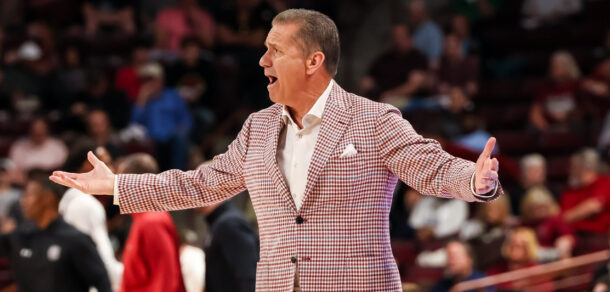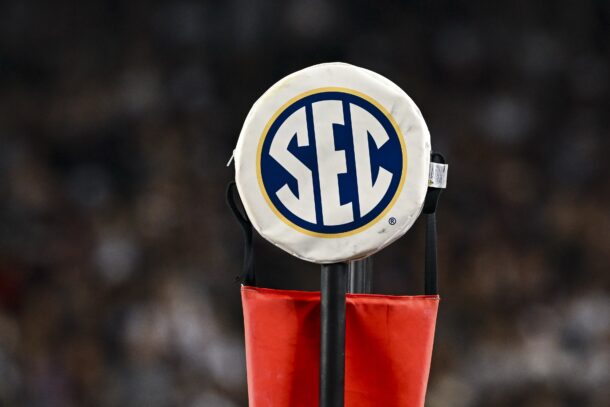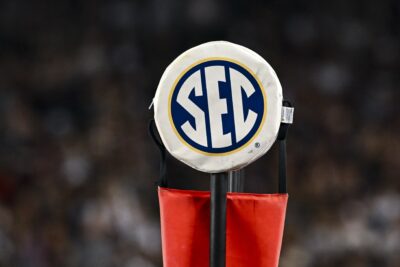Ad Disclosure

NCAA Tournament bubble watch: Suddenly hot South Carolina has become a potential SEC bubble-buster
The NCAA Tournament record for most bids by a single conference is 11, set by the Big East in 2011. This year’s SEC is on pace to at least equal, if not beat that mark.
Unless South Carolina has something to say about it.
The Gamecocks are in the midst of a miserable season at 12-17. They’re dead last in the conference and going nowhere fast. But after losing 14 straight to start their SEC schedule, they’ve suddenly hit on a winning formula.
And it couldn’t have come at a worse time for their conference rivals trying to stay on the right side of the NCAA Tournament bubble.
First, Lamont Paris’s team delivered a 15-point rout of Texas, a result that immediately negated the positive impact of the Longhorns’ win at Kentucky a week earlier and sent them into a 3-game tailspin.
Then Saturday, South Carolina put an equally unsightly blemish on Arkansas’s postseason resume by hanging a 72-53 beatdown on John Calipari’s Razorbacks that was even worse than the final score indicates.
Arkansas didn’t reach double-figure scoring – as a team, not individually – until the final 3 minutes of the half. They didn’t break 20 until the 12:35 mark of the second half and shot just 28.8% from the floor and went 3-for-22 from beyond the 3-point arc.
“It was a dud,” Calipari said afterward. “It was humiliating.”
Yes it was.
And the Razorbacks don’t have much time to try and mitigate the damage. They’re still in decent shape in the NET at No. 47 with 4 Quad 1 wins. But at just 17-12 overall and 6-10 in the conference, they’re not a Tournament lock by any means.
Neither are Georgia, Oklahoma or Texas. A lot will depend on how heavily the selection committee weighs the SEC’s depth and quality against conference records that are likely to end up multiple games below .500. It’s an interpretation that will determine whether or not the conference breaks the Tournament record of 11 bids. And by how much.
This final week of the regular season could be a tipping point.
While the first 10 teams in the SEC standings, 9 of which are ranked, are all solidly in the field of 68, it would be helpful for the 4 hopefuls with sub-.500 conference records below them to make a strong closing argument before they put their fate into the hands of the selection committee.
Especially the Bulldogs, whose next game is in Columbia against those suddenly hot, bubble-bursting Gamecocks.
SEC teams aren’t the only ones working to put themselves in position for the final few spots in the NCAA’s 68-team field. Here’s a look at how the bubble stacks up throughout college basketball:
- ACC: North Carolina (19-11, 12-6, 42 NET), SMU (21-8, 12-6, 41 NET). The Tar Heels have won 5 straight, but all of the victories have come against the bottom third of their conference. If they can survive a trap game against another bottom-feeder Tuesday against Virginia Tech they’ll have an opportunity to catapult themselves into the bracket against No. 2 Duke on Saturday. UNC’s best asset is that 10 of its 11 losses are of the Quad 1 variety. Its biggest liability is that it has only 1 Quad 1 victory. But that’s still 1 more than ACC rival SMU, which also had 3 Quad 2 losses despite a slightly better NET. Wake Forest, meanwhile, has played itself off the bubble with losses to NC State and Virginia, followed by a 37-point whipping at the hands of Duke on Monday.
- Big Ten: Indiana (18-11, 9-9, 55 NET), Nebraska (17-12, 7-11, 57 NET), Ohio State (16-13, 8-10, 36 NET). The Big Ten will likely be a litmus test on how much importance the selection committee puts on metrics compared to actual wins and losses. Ohio State, in particular. The Buckeyes are just 16-13, 8-10 in the conference with 4 losses in their last 6 games. But their NET is strong at No. 36. Their final 2 games are against fellow bubble teams Nebraska and Indiana will go a long way to determining the fate of all 3 contenders. Indiana figures to be in the best shape despite a problematic NET. But at least the Hoosiers are hot, having won 4 of the last 5 with a pair of ranked upsets.
- Big 12: Baylor (17-12, 9-9, 32 NET), West Virginia 17-12, 8-10, 48 NET), Cincinnati (17-12, 7-11, 40 NET). The Bears should be in good shape as long as they don’t stumble against TCU on Tuesday. And they can take themselves out of First Four consideration by finishing the regular season with an upset of No. 3 Houston. Both the Mountaineers and Bearcats still have a lot of work to do, beyond the final 2 regular season games. Of the 2, WVU has a much more realistic shot at sneaking into the field because of its 5 Quad 1 wins, compared to only 1 for Cincinnati.
- Big East: Xavier (19-10, 1107, 49 NET), Villanova (18-12, 11-8, 51 NET). The Musketeers’ resume is similar to that of North Carolina in the ACC. A lot of wins against teams below them in the standings, but only 1 victory of note. They did help their case on Saturday, however, with a convincing 83-61 win against NCAA team Creighton. The Wildcats, meanwhile, have rallied from a slow start by winning 6 of their last 8. But their NCAA hopes will depend on their ability to carry that momentum into the conference tournament.
- SEC: Georgia (18-11, 6-10, 33 NET), Arkansas (17-12, 4-9, 47 NET), Texas (16-13, 5-11, 46 NET), Oklahoma (17-12, 4-12, 53 NET). The Bulldogs are the only team that helped themselves last week by winning twice, including an upset of No. 4 Florida. The Razorbacks, Longhorns and Sooners all stumbled in games they couldn’t afford to lose. And they’ll all play one other this week. The Texas-Oklahoma regular-season finale on Saturday could be an elimination game. Especially for the Sooners, whose season trajectory after going undefeated in the nonconference portion of the schedule is similar to the one that kept South Carolina out of the tournament in 2016.
- Mid-majors: San Diego State (20-7, 13-5 Mountain West, 50 NET), Boise State (21-8, 13-5, 43 NET). A year ago, both teams would be safely in the field. But the combination of the Mountain West’s disappointing Tournament performance last March and less depth in the conference this season, both are squarely on the bubble. Both teams did what they could to strengthen their case by going 2-0 last week. But where they fall on the bubble will depend a lot on how many bids get stolen and how much value the committee decides to place on the competition in the Mountain West.
Award-winning columnist Brett Friedlander has covered the ACC and college basketball since the 1980s.



